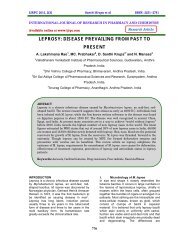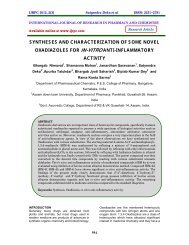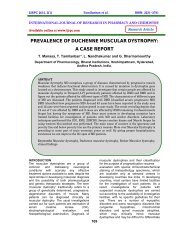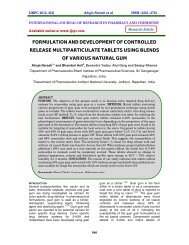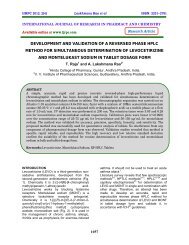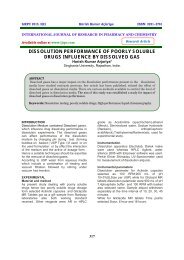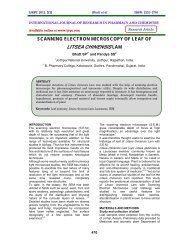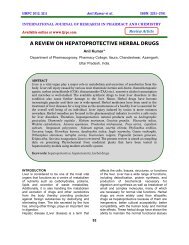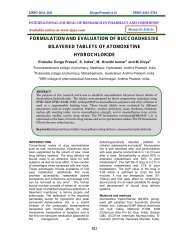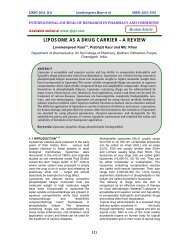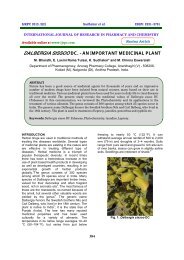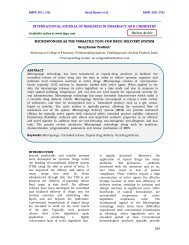preparation, characterization and evaluation of pgs - pvp co ... - ijrpc
preparation, characterization and evaluation of pgs - pvp co ... - ijrpc
preparation, characterization and evaluation of pgs - pvp co ... - ijrpc
You also want an ePaper? Increase the reach of your titles
YUMPU automatically turns print PDFs into web optimized ePapers that Google loves.
IJRPC 2012, 2(3) Chowdary et al ISSN: 22312781<br />
INTRODUCTION<br />
Direct <strong>co</strong>mpression is the preferred method for<br />
the <strong>preparation</strong> <strong>of</strong> tablets [1] . It <strong>of</strong>fers several<br />
advantages 2-3 .Notable among them are (i) It is<br />
e<strong>co</strong>nomical <strong>co</strong>mpared to wet granulation since<br />
it requires fewer unit operations (ii) More<br />
suitable for moisture <strong>and</strong> heat sensitive APIs<br />
since it eliminates wetting <strong>and</strong> drying steps (iii)<br />
Changes in dissolution pr<strong>of</strong>ile are less likely to<br />
occur in tablets made by direct <strong>co</strong>mpression<br />
method on storage than in those made from<br />
granulations 4 .This is extremely important<br />
because the <strong>of</strong>ficial <strong>co</strong>mpendium now requires<br />
dissolution specifications in most solid dosage<br />
forms 5 . Disintegration or dissolution is the rate<br />
limiting step in absorption in the case <strong>of</strong> tablets<br />
<strong>of</strong> poorly soluble API prepared by wet<br />
granulation. The tablets prepared by direct<br />
<strong>co</strong>mpression disintegrate into API particles<br />
instead <strong>of</strong> granules that directly <strong>co</strong>me into<br />
<strong>co</strong>ntact with dissolution fluid <strong>and</strong> exhibits<br />
<strong>co</strong>mparatively faster dissolution.<br />
The direct <strong>co</strong>mpression process is mainly<br />
influenced by the properties <strong>of</strong> the excipients.<br />
The physi<strong>co</strong> mechanical properties <strong>of</strong><br />
excipients that ensure a robust <strong>and</strong> successful<br />
process are good flowability, good<br />
<strong>co</strong>mpressibility, low or no moisture sensitivity,<br />
low lubricant sensitivity, <strong>and</strong> good<br />
machineability even in high –speed tabletting<br />
machinery with reduced dwell times 6 . The<br />
majority <strong>of</strong> the excipients that are currently<br />
available fail to give up to these functionality<br />
requirements, thus creating the opportunity for<br />
the development <strong>of</strong> new high-functionality<br />
excipients. An efficient platform for the<br />
manipulation <strong>of</strong> excipient functionality is<br />
provided by <strong>co</strong>-processing two or more<br />
existing excipients. Co-processing is based on<br />
the novel <strong>co</strong>ncept <strong>of</strong> two or more excipients<br />
interacting at the sub particle level, the<br />
objective <strong>of</strong> which is to provide a synergy <strong>of</strong><br />
functionality improvements as well as masking<br />
the undesirable properties <strong>of</strong> individual<br />
excipients 7 . The availability <strong>of</strong> a large number<br />
<strong>of</strong> excipients for <strong>co</strong>-processing ensures<br />
numerous possibilities to produce tailor-made<br />
“designer excipients” to address specific<br />
functionality requirements. Co-processed<br />
excipients are prepared by in<strong>co</strong>rporating one<br />
excipient into the particle structure <strong>of</strong> another<br />
excipient using processes such as <strong>co</strong>-drying.<br />
Co-processing <strong>of</strong> excipients in the<br />
pharmaceutical industry can be dated back to<br />
the late 1980’s with the introduction <strong>of</strong> <strong>co</strong>processed<br />
microcrystalline cellulose <strong>and</strong><br />
calcium carbonate 8 , followed by Cellactose<br />
(Meggle Corp., Wasserburg, Germany) in<br />
1990, which is a <strong>co</strong>-processed <strong>co</strong>mbination <strong>of</strong><br />
cellulose <strong>and</strong> lactose. A similar principle was<br />
applied in developing silicified microcrystalline<br />
cellulose (SPVP), which is the most widely<br />
861<br />
used <strong>co</strong>-processed excipient 9 .The objective <strong>of</strong><br />
the present study is to prepare <strong>and</strong><br />
characterize pregelatinized starch-poly vinyl<br />
pyrrolidone (PGS-PVP) <strong>co</strong>-processed<br />
excipient <strong>and</strong> to evaluate its application as<br />
directly <strong>co</strong>mpressible vehicle in tablet<br />
formulations. PGS-PVP <strong>co</strong>- processed<br />
excipeint was prepared by gelatinizing potato<br />
starch in the presence <strong>of</strong> PVP <strong>and</strong> drying the<br />
resulting mass.<br />
EXPERIMENTAL<br />
Materials<br />
Efavirenz, ritonavir, stavudine <strong>and</strong> poly vinyl<br />
pyrrolidone (PVP) were gift samples from M/s<br />
Eisai Pharmatechnology <strong>and</strong> Manufacturing<br />
Pvt. Ltd., Visakhapatnam. Potato starch,<br />
lactose, talc <strong>and</strong> magnesium stearate were<br />
procured from <strong>co</strong>mmercial sources. All other<br />
materials used were <strong>of</strong> Pharma<strong>co</strong>poeial grade.<br />
METHODS<br />
Preparation <strong>of</strong> PGS-PVP Co-processed<br />
Excipient<br />
Potato starch (49parts) <strong>and</strong> poly vinyl<br />
pyrrolidone (1 part) were dispersed in 20 parts<br />
<strong>of</strong> water to form a smooth slurry. Purified water<br />
(40 parts) was taken in a separate beaker <strong>and</strong><br />
heated to boiling. Starch - PVP slurry was<br />
added to boiling water while stirring. Stirring<br />
while heating was <strong>co</strong>ntinued for 15 to 20<br />
minutes to form a thick mass. The product<br />
formed was <strong>co</strong>llected on to stainless steel tray<br />
<strong>and</strong> dried at 80 o c for 12 hours. The dried<br />
product was grinded <strong>and</strong> sized to obtain -<br />
72+100 mesh sized particles.<br />
Characterization <strong>of</strong> PGS-PVP Co-processed<br />
excipient<br />
PGS-PVP <strong>co</strong>-processed excipient prepared<br />
was characterized by determining melting<br />
point, solubility, swelling index in water, pH,<br />
<strong>and</strong> micromeritic characters namely particle<br />
size, bulk density, tapped density, angle <strong>of</strong><br />
repose <strong>and</strong> <strong>co</strong>mpressibility index <strong>and</strong> by FTIR<br />
spectra.<br />
Solubility<br />
Solubility <strong>of</strong> PGS-PVP was tested in water,<br />
aqueous buffers <strong>of</strong> pH 1.2, 4.5, <strong>and</strong> 7.4 <strong>and</strong><br />
organic solvents such as al<strong>co</strong>hol,<br />
dichloromethane, chlor<strong>of</strong>orm, acetone <strong>and</strong><br />
petroleum ether.<br />
pH<br />
The pH <strong>of</strong> a 1% w/v slurry was measured.<br />
Melting point<br />
Melting point was determined by using melting<br />
point apparatus.



